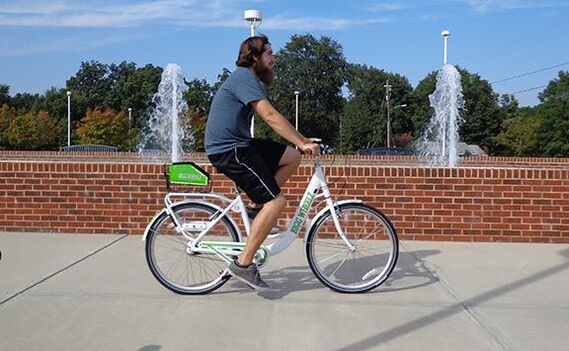
University Bicycle
Biking has become an integral part of university life, offering students an eco-friendly, cost-effective, and healthy mode of transportation. As campuses embrace the benefits of biking, university bike sharing programs have gained popularity. In this article, we will explore the advantages of university bike, delve into the mechanics of bike sharing initiatives, and highlight the positive impacts on students and the environment.
Benefits of University Bikes
Cost-Effectiveness for Students
University life often comes with financial challenges. Owning a car can be expensive, making bikes an attractive alternative for students looking to save money on transportation. The initial cost of purchasing a bike is significantly lower than that of a car, and maintenance expenses are also minimal.
Environmental Impact and Sustainability
Biking is an eco-friendly mode of transportation that helps reduce carbon emissions. With the growing concern for environmental sustainability, universities are encouraging biking as a green alternative. This not only contributes to a cleaner environment but also aligns with the values of environmentally conscious students.
Sharing Bike Programs
Overview of Bike Sharing Initiatives on University Campuses
Many universities have implemented bike sharing programs to provide students with convenient access to bikes. These programs typically involve a fleet of bikes stationed at various locations across the campus, available for short-term use.
Advantages of Sharing Bikes in a University Setting
Bike sharing programs offer flexibility and accessibility. Students can easily pick up a bike at one location and drop it off at another, promoting seamless transportation within the campus. This system also reduces the need for personal bike ownership, making biking accessible to a broader student population.
How University Bike Sharing Works
Registration and Access Process
University bike-sharing programs usually require students to register, providing them with a unique identification or access code. This code is used to unlock bikes at designated stations. Mobile apps have streamlined this process, allowing students to locate available bikes, unlock them, and track usage through their smartphones.
Utilizing Mobile Apps for Convenience
The integration of mobile apps enhances the convenience of university bike sharing. These apps provide real-time information on bike availability, station locations, and even fitness tracking features. Students can plan their routes and make informed decisions based on the data provided by these apps.
Promoting Healthy Lifestyles
Discussing the Physical and Mental Health Benefits of Biking
Beyond the practicality of transportation, biking contributes to the overall well-being of students. Physical exercise is essential for maintaining a healthy lifestyle, and biking offers a fun and accessible way to stay active. Moreover, the mental health benefits of outdoor activities and the sense of freedom while biking contribute to a positive university experience.
Encouraging Active Transportation on Campuses
University campuses are ideal environments for promoting active transportation. Biking not only offers a quick and efficient way to navigate large campuses but also contributes to a vibrant and active atmosphere. Encouraging students to bike between classes fosters a culture of wellness and engagement.
Community Building Through Biking
Creating a Sense of Community Among Students
Biking brings people together. University bike clubs and events provide platforms for students to connect over a shared interest in biking. These communities not only foster friendships but also contribute to a sense of belonging and shared identity among students.
Organizing Biking Events and Clubs
Universities can further strengthen the biking community by organizing events such as group rides, bike races, or maintenance workshops. These activities create opportunities for students to bond, share experiences, and learn from one another.
Safety Measures
Importance of Bike Safety on Campuses
While biking offers numerous benefits, safety is paramount. Universities need to prioritize bike safety by implementing clear signage, designated bike lanes, and education programs for both pedestrians and cyclists. Creating a safe biking environment enhances the overall experience for students.
Tips for Safe Biking in University Environments
To ensure a safe biking experience, students should follow traffic rules, wear helmets, and be aware of their surroundings. Additionally, universities can provide resources such as safety workshops and online guides to educate students on responsible biking practices.
Case Studies
Highlighting Successful University Bike-Sharing Programs
Several universities have successfully implemented bike sharing programs with positive outcomes. Case studies will showcase the effectiveness of these initiatives, including increased bike usage, reduced traffic congestion, and enhanced student satisfaction.
Showcasing Positive Impacts on Campuses
Examining the positive impacts of university bike sharing programs will highlight the broader benefits for campuses. These may include improved air quality, reduced parking demand, and a healthier and more active student population.
Challenges and Solutions
Addressing Common Challenges in Implementing Bike-Sharing Programs
While university bike sharing programs offer numerous advantages, they may face challenges such as limited infrastructure, resistance to change, and concerns about theft or damage. Addressing these challenges head-on is crucial for the success and sustainability of such programs.
Providing Solutions for Overcoming Obstacles
Solutions may include expanding biking infrastructure, implementing awareness campaigns, and utilizing technology to enhance security measures. By proactively addressing challenges, universities can create an environment that encourages and supports biking.
Future Trends in University Biking
Discussing the Evolving Landscape of University Bike Programs
The landscape of university biking is continually evolving. This section will explore emerging trends, such as advancements in bike sharing technology, integration with public transportation, and innovative approaches to promote biking on campuses.
Predicting Future Advancements and Developments
As technology advances and sustainability becomes an even more significant focus, we can anticipate further developments in university biking. Predictions may include enhanced bike sharing app features, increased investment in biking infrastructure, and collaborative efforts with local communities.
Student Testimonials
Real-Life Experiences of Students Using University Bikes
Including firsthand accounts from students who have embraced biking on campus adds a personal touch to the article. These testimonials will highlight the practical benefits, joys, and challenges of incorporating biking into university life.
Personal Stories Showcasing the Advantages of Biking on Campus
Sharing stories of students who have experienced positive outcomes from using university bike can inspire others to adopt this sustainable and healthy mode of transportation.
Comparing University Bike Programs
Analyzing Different University Bike Sharing Models
Universities may adopt various models for their bike sharing programs. This section will compare and contrast different approaches, discussing the strengths and weaknesses of each model.
Identifying Successful Strategies for Implementation
By analyzing successful university bike programs, readers can gain insights into effective strategies for implementation. This information can be valuable for universities planning to establish or improve their own bike sharing initiatives.
Environmental Impact
Emphasizing the Positive Effects of Reduced Carbon Footprint
The environmental impact of biking cannot be overstated. This section will delve into the positive effects of reduced carbon emissions, decreased reliance on fossil fuels, and the role of biking in creating a more sustainable campus.
Exploring How Biking Contributes to a Sustainable Campus
Biking aligns with the broader goal of creating sustainable campuses. Exploring initiatives such as bike-friendly infrastructure, bike recycling programs, and partnerships with environmentally conscious organizations will highlight the multifaceted contributions of biking to sustainability.
University Bike Policies
Overview of University Policies Supporting Bike Usage
To encourage biking, universities need supportive policies. This section will provide an overview of existing policies that promote bike usage, such as designated bike lanes, secure bike storage, and incentives for choosing biking over other forms of transportation.
Advocacy for Improved Biking Infrastructure on Campuses
Advocating for improved biking infrastructure is crucial for the success of university biking programs. This may include collaborating with local governments, securing funding for bike lane expansion, and engaging with the university community to garner support for enhanced biking facilities.
Conclusion
In conclusion, university biking is more than just a mode of transportation; it’s a lifestyle that fosters community, promotes health, and contributes to environmental sustainability. As campuses continue to embrace the benefits of biking, students are reaping the rewards of a more active and connected university experience.







